|
|
 |
Fiche d'espèce de Copépode |
|
|
Monstrilloida ( Ordre ) |
|
|
|
Monstrillidae ( Famille ) |
|
|
|
Cymbasoma ( Genre ) |
|
|
| |
Cymbasoma longispinosum (Bourne, 1890) (F,M) | |
| | | | | | | Syn.: | Monstrilla longispinosa Bourne,1890 b (p.575, figs.F);
Thaumaleus longispinosus Giesbrecht, 1892 (p.578, 585, figs.F,M); Malaquin, 1901 (p.111); van Breemen, 1908 a (p.211, figs.F,M); Pesta, 1920 (p.633, fig.F); Rose, 1925 e (p.307); 1926 (p.47); ? Dakin & Colefax, 1940 (p.117, figs.M); C.B. Wilson, 1950 (p.197); Isaac, 1974 (p.130); 1975 (p.3, 7, 8, figs.F,M); Huys & Boxshall, 1991 (p.164, fig.M); Dias de O., 1996 (p.255, Rem.);
no Cymbasoma longispinosum : Martin Thompson, 1973 (1976) (p.617, figs.F,M, Rem.: Kerala form).
Non Cymbasoma longispinosum : Dolgopol'skaya, 1948 (p.178, figs.F);
non C. longispinosum male: Dakin & Colefax, 1940 [probably C. jinigudira Suarez-Morales & McKinnon, 2016] | | | | Ref.: | | | Sars, 1921 a (p.24, figs.F,M); Rose, 1933 a (p.349, figs.F,M); Sekiguchi, 1982 (p.26, figs.M); Martin Thompson & Easterson, 1983 (p.179, Rem.); Grygier, 1994 a (p.28, Rem.); Grygier, 1995 a (p.46, 51,70); Suarez-Morales & Escamilla, 1997 (p.545: Rem.); Chihara & Murano, 1997 (p.1002, Pl.234: M); Suarez-Morales & Palomares-Garcia, 1999 (p.197, tab.1); Suarez-Morales, 2000 b (p.680); 2002 (p.95: tab.1); Leite & al., 2010 (p.577, figs.F,M); Vives & Shmeleva, 2010 (p.162, figs.F,M, Rem.); Suarez-Morales, 2011 (p.6, 9, 10, Rem.); Üstün & al., 2014 (p.1402, 1408 Table I, II, Rem.: C. longispinosum/em> s.str. & from Brazil) | 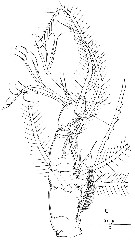 issued from : R. Huys & G.A. Boxshall in Copepod Evolution, The Ray Society, 1991. [p.164, Fig.2.5.7]. As Thaumaleus longispinosus. Male: C, A1.
|
 Issued from : W. Giesbrecht in Systematik und Faunistik der Pelagischen Copepoden des Golfes von Neapel und der angrenzenden Meeres-Abschnitte. - Fauna Flora Golf. Neapel, 1892. Atlas von 54 Tafeln. [Taf.46, Fig.1]. As Thaumaleus longispinosus. Male: 1, habitus (lateral).
|
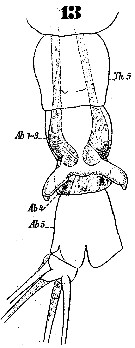 Issued from : W. Giesbrecht in Systematik und Faunistik der Pelagischen Copepoden des Golfes von Neapel und der angrenzenden Meeres-Abschnitte. - Fauna Flora Golf. Neapel, 1892. Atlas von 54 Tafeln. [Taf.46, Fig.13]. As Thaumaleus longispinosus. Male: 13, urosome (ventral)
|
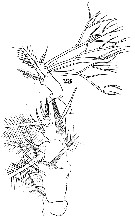 Issued from : W. Giesbrecht in Systematik und Faunistik der Pelagischen Copepoden des Golfes von Neapel und der angrenzenden Meeres-Abschnitte. - Fauna Flora Golf. Neapel, 1892. Atlas von 54 Tafeln. [Taf.46, Fig.23]. As Thaumaleus longispinosus. Male: 23, A1 (ventral view).
|
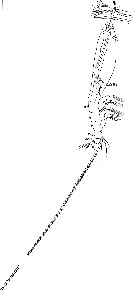 Issued from : W. Giesbrecht in Systematik und Faunistik der Pelagischen Copepoden des Golfes von Neapel und der angrenzenden Meeres-Abschnitte. - Fauna Flora Golf. Neapel, 1892. Atlas von 54 Tafeln. [Taf.46, Fig.4]. As Thaumaleus longispinosus. Female: 4, habitus (lateral).
|
 Issued from : W. Giesbrecht in Systematik und Faunistik der Pelagischen Copepoden des Golfes von Neapel und der angrenzenden Meeres-Abschnitte. - Fauna Flora Golf. Neapel, 1892. Atlas von 54 Tafeln. [Taf.46, Fig.6]. As Thaumaleus longispinosus. Female: 6, habitus (dorsal).
|
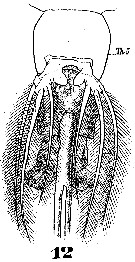 Issued from : W. Giesbrecht in Systematik und Faunistik der Pelagischen Copepoden des Golfes von Neapel und der angrenzenden Meeres-Abschnitte. - Fauna Flora Golf. Neapel, 1892. Atlas von 54 Tafeln. [Taf.46, Fig.12]. As Thaumaleus longispinosus. Female: 12, urosome (ventral).
|
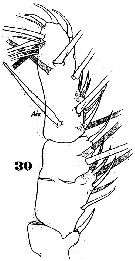 Issued from : W. Giesbrecht in Systematik und Faunistik der Pelagischen Copepoden des Golfes von Neapel und der angrenzenden Meeres-Abschnitte. - Fauna Flora Golf. Neapel, 1892. Atlas von 54 Tafeln. [Taf.46, Fig.30]. As Thaumaleus longispinosus. Female: 30, A1 (ventral view).
|
 Issued from : W. Giesbrecht in Systematik und Faunistik der Pelagischen Copepoden des Golfes von Neapel und der angrenzenden Meeres-Abschnitte. - Fauna Flora Golf. Neapel, 1892. Atlas von 54 Tafeln. [Taf.46, Fig.38]. As Thaumaleus longispinosus. Female: 38, P5.
|
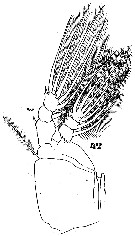 Issued from : W. Giesbrecht in Systematik und Faunistik der Pelagischen Copepoden des Golfes von Neapel und der angrenzenden Meeres-Abschnitte. - Fauna Flora Golf. Neapel, 1892. Atlas von 54 Tafeln. [Taf.46, Fig.42]. As Thaumaleus longispinosus. Female: 42, P3.
|
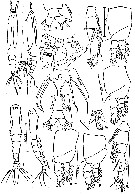 issued from : P.K. Martin Thompson in J. mar. biol. Ass. India, 1973 (1976), 15 (2). [p.618, Fig.1]. Female (from coastal waters off Vizhinjan, Kerala, SW India): a-b, habitus (dorsal and lateral, respectively); c, cephalothorax (anterior region enlarged); d, anal segment and caudal rami (enlarged); e, abdomen (lateral, enlarged); f, A1; g, P1; h, P2; i, P5. Nota: Ratio of cephalothorax: rest of body 65.37 : 34.63. Proportional lengths of various segments of body (caudal rami included): 65.37; 8.29; 6.83; 5.85; 4.88; 3.90; 2.44; 2.44 = 100. A1 4-segmented, attains 1/4 of cephalothorax, last segment longest, but not as long as combined length of first three segments, proportional lengths 17.0; 19.3; 16.0; 47.7 = 100. Male: j-k, habitus (dorsal and lateral, respectively); l, abdomen and caudal rami (dorsal); m, copulatory organ with seminal vesicle; n, A1; o, P1; p, P3. Nota: Posterolateral corners of cephalothorax slightly bulged out bears a pair of minute nerve hooks on each side. Ratio of cephalothorax : rest of body 44.78 : 55.22. Abdomen 3-segmented and hardly 1/7 of total length. Genital segment (Abd 2) has a blunty pointed well developed copulatory organ consisting of a pair of long and diverging lobes situated at postero-lateral corners of segment. Caudal rami as in female, but with 4 plumose setae of equal length. Proportional lengths of various segments of body (caudal rami included): 44.78; 10.45; 9.45; 9.45; 6.97; 5.47; 3.48; 4.98; 4.97 = 100. A1 5-segmented, comparatively much longer than that of female; first three segments being lamellary; last segment being thinner and moveably articulated to fourth; proportional lengths 14.93; 18.41; 13.93; 27.36; 25.37 = 100. Swimming legs as in female. P5 absent.
|
 issued from : P.K. Martin Thompson in J. mar. biol. Ass. India, 1973 (1976), 15 (2). [p.619, Table.1]. The setae and spine on the hree segments of exopodite and endopodite of swimming legs.
|
 issued from : P.K. Martin Thompson in J. mar. biol. Ass. India, 1973 (1976), 15 (2). [p.620]. Characters between Sars' species from NE Atlantic and Kerala form (India).
|
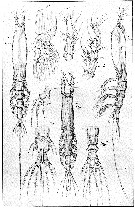 issued from : G.O. Sars in An Account of the Crustacea of Norway, with short descriptions and figures of all the species, 1921a, 8. [Pl. XIII]. Female and Male (from Mediterranean Sea: off Sardinia). Specific characters of Female: Cephalic segment only very slightly dilated in the middle, and considerably exceeding half the length of the body. Eye well developed. A1 4-segmented, short and stout, scarcely exceeding in length1/4 of the cephalic segment ; the last segment about the length of the other 3 combined and gradually narrowed distally, some of its setae ramified. Oral tubule located far in fronf, at only at short distance from the frontal part of the head. Natatory legs with the terminal segment of exopod unusually short, scarcely longer than the middle one. P5 provided at the obtusely truncated extremity with 3 plumose setae, the innermost of which is a little shorter than the other 2 ; inner lobe well defined, triangular, and extending at right angle to the axis of the leg. Abdomen short, not attaining the length of the 2 preceeding segments combined. Genital segment about the size of the last trunkal segmend and, in dorsal view, of a subquadrate form, its ventral face considerably protuberant. Ovigerous spines of an extraordinary length, attaining nearly the double length of the body, and confluent at the base for some distance, distal part much narrower than the proximal one. Caudal rami very small, scarcely longer than they are broad, each only provided with 3 thickish setae of equal length. Specific characters of Male: A1 5-segmented, the 3 middle ones lamellary expanded inside and armed with several short spines in addition to the setae, last segment small, very movably articulated to the preceding one. Natatory legs as in the female ; P5 wholly absent. Genital segment with the copulative appendage divided at the end into 2 short diverging lobes. Caudal rami, each provided with 4 setae of nearly equal length (instead 3 setae for the female).
|
 Issued from : Suarez-Morales in Mitt. Mus. Nat.kd. Berl., Zool. Reihe, 2002, 78. [p.95, Table 1]. Comparison of main taxonomic features in species of Cymbasoma with a cephalothorax relative length equal or over 60%, females only: C. longispinosum Bourne, 1890. Mouth position way back anterior part of forehead in percentage of the cephalothorax length. Compare with C. bowmani, C. boxshalli, C. morii, C. nicolettae, C. quintanarooense, C. striatus, C. thompsoni, C. tumorifrons, C. sp. (from Brazil), C. chelemense.
|
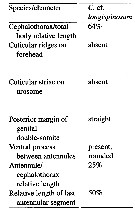 Issued from : F. Üstün, T. Terbiyik Kurt & E. Suarez-Morales in Crustaceana, 2014, 87 (11-12). [p.1403, Table I]. Taxonomic features and morphometry of females of Cymbasoma longispinosum from Brazil (Leite & al., 2012). Nota: The point of bifurcation of the ovigerous spines at the distal end of the caudal ramus is a character useful to distinguish C. janetae and helps in recognizing the form from Brazil as a different species.
|
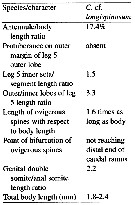 Issued from : F. Üstün, T. Terbiyik Kurt & E. Suarez-Morales in Crustaceana, 2014, 87 (11-12). [p.1404, Table I (continued)]. Taxonomic features and morphometry of females of Cymbasoma longispinosum from Brazil (Leite & al., 2012).
| | | | | Ref. compl.: | | | Gurney, 1927 (p.169); C.B. Wilson, 1950 (p.197); Dowidar & El-Maghraby, 1970 (p.268) ; Hure & Krsinic, 1998 (p.98, 105); Dias & Bonecker, 2007 (p.270, 272, fig.3, tab.II); Oliveira Dias & Costa Bonecker, 2007 (p.282: Rem); Oliveira Dias & al., 2008 (p.248, tab.1) | | | | NZ: | 10 | | |
|
Carte de distribution de Cymbasoma longispinosum par zones géographiques
|
| | | | | | | | | | Loc: | | | Baie des Chaleurs, Shetland Is., Norway, North Sea, English Channel, Plymouth, Guinea Bissau, Brazil (Natal-Portal do Sul, Bahia, Amazon estuary), Portugal, Medit. (Algiers, Thau Lagoon, Marseille, Napoli, North Africa, N Adriatic Sea, Lebanon, Alexandria), ? Black Sea, ? Suez Canal (in Gurney, 1927), Arabian Gulf, W India (Bombay, ? Vizhinjam), Philippines, Viet-Nam, Japan, Australia (New South Wales) | | | | N: | 20 | | | | Lg.: | | | (46) F: 3,1-2,6; M: 1,8; (104) M: 1,8; (277) F: 2,8; 2,5; (449) F: 3,1-2,6; M: 1,8; (466) F: 2,55-2,01; M: 1,57-1,33; (663) F: 3,16-2,6; M: 2,3; (723) M: 1,5; (782) F: 2,6; (783) F: 3,18-1,9; M: 1,72-1,21; (995) F: 1,96-2,06; M: 1,45*; (997) F: 1,28-2,01; M: 0,68*; (1056)* F: 1,80-2,48; M: 1,00-1,53; {F: 1,80-3,18; M: 1,00-2,30}
*: caudal rami excluded. | | | | Rem.: | For Suarrez-Morales & Escamilla (1997, p.545 & suiv.) this species is closely related to C. chelemense.
For Suarez-Morales (2011, p.6) and Üstün & al. (2014, p.1402) since Bourne's (1890) original description of C. longispinosum from the English Channel, the species has been recorded in very different geographic areas and latitudes. The improbability of a single monstrilloid species being so widely distributed aside, some of these authors noted morphologic differences with respect to the original description of C. longispinosum, it was later realized that this group of species diverging represent cryptic species, each with a limited geographic distribution. This notion supported the erection of the longispinosum specuies-group. The species-group longispinosum is currently known to contain at least 5 nominal species showing subtle but consistent differences and are distributed in distinct geographical areas. Records of C. longispinosum from India (Martin Thompson, 1973) have been tentatively assigned to C. morii (Grygier, 1994), and the Brazilian specimens reported as C. longispinosum by Leite & al. (2010) probably represent an undescribed species (Suarez-Morales, 2011), as C. longispinosum from Dolgopolskaya (1948) in the Sebastopol Bay shall be assignable to the new species C. sinopense from the Tutkey coasts (Üstün & al., 2014) (See remaks at this species).
After Suarez-Morales & McKInnon (2016, p.88) the previous Australian record of C. longispinosum based on a male specimen (Dakin & Colefax, 1940) could be referable to C. jinigudira Duarez-Morales & McKinnon (2016, p.88). The structure of the genital complex with a medial rounded protuberance fig205Dd) and some additional characters discernible from their illustrations (like the large, wide anal somite and the presence of 4 caudal setae are reminiscent of the male of C. jinigudira. | | | Dernière mise à jour : 28/07/2020 | |
|
|
 Toute utilisation de ce site pour une publication sera mentionnée avec la référence suivante : Toute utilisation de ce site pour une publication sera mentionnée avec la référence suivante :
Razouls C., Desreumaux N., Kouwenberg J. et de Bovée F., 2005-2025. - Biodiversité des Copépodes planctoniques marins (morphologie, répartition géographique et données biologiques). Sorbonne Université, CNRS. Disponible sur http://copepodes.obs-banyuls.fr [Accédé le 28 décembre 2025] © copyright 2005-2025 Sorbonne Université, CNRS
|
|
 |
 |



















